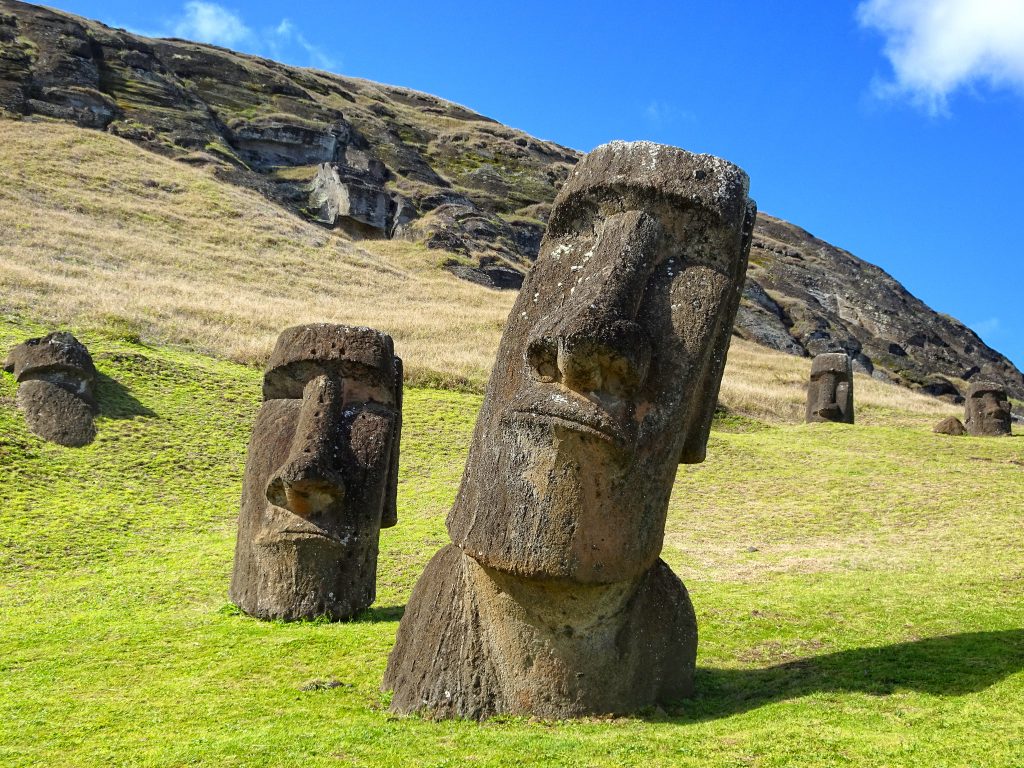For roughly three millennia, the Abu Simbel Temple was located on the west bank of the Nile river. When the 1960s came along, though, a meticulously planned effort to move the temples to a different location was executed, as the Nile was rising, threatening to flood the historical site.
As a result, the Aswan High Dam had to be built, which meant that somehow, two gigantic structures thousands of years old had to be moved.
In this article we’ll explore insider traveller tips and lesser known history of the Abu Simbel Temple.
Quick Facts on the Abu Simbel Temple:
- Location: Aswan, Egypt on the banks of Lake Nasser
- Original name: The temple of Ramesses-Meryamun
- Construction: 13th century BC
- Commissioned by: Pharaoh Ramses II
- Purpose: Monument to commemorate his victory at the Battle of Kadesh
- Dedicated to: Amun, Ra-Horakhty, Ptah, and the deified Ramses II
- Size: Statues of Ramses II are about 20 meters high
- Relocation: 1986
- Distance from Aswan: 288 km
How to get to the Abu Simbel Temple
The distance between Aswan and Abu Simbel is 280 kilometers and Luxor lies 591km away.
- Daily flights: from Aswan to Abu Simbel.
- Depart around 10:00 am and will be back around 2:00 pm
- Cost: you about 250 US-Dollar per person.
- By tourist bus: (this one has very good reviews) for a fraction of that price and roughly 7 hours on the bus driving through the Nubian desert
The History of the Abu Simbel Temples
Located at a site called Abu Simbel in Nubia, Upper Egypt, the eponymous rock temples were created in 1244 BCE, under the orders of pharaoh Ramesses II (1303-1213 B.C.). The two temples were part of the Nubian Monuments, recognized as a UNESCO World Heritage Site. They were intended to represent Ramesses II’s victory at the Battle of Qadesh, and were built to honor both him and Nefertari, his queen.
To better understand the significance of the temples — and the thought process that went behind their construction — one need simply to examine the profile of Ramesses II. As the pharaoh, he took an active role in expanding Egypt’s territory, eventually finding himself in combat with the Hittites in the Battle of Qadesh in Syria.
Ramesses II was fond of showcasing his achievements. It was this desire to brag about his victory that led to the planning and eventual construction of the temples. (Interestingly, historians say that the Battle of Qadesh actually ended in a draw based on the depicted story — not quite the definitive victory Ramesses II was making it out to be.)
As mentioned earlier, there were two temples on the site. One of them, the Great Temple, was larger than the other. The Great Temple was also called “The Temple of Ramesses-Meryamun” (“Ramesses, beloved by Amun”). This temple was built to measure 98 ft (30 m) in height and 115 ft (35 m) in length.
Upon entering the temple, the first room you would see is an atrium with four pillars on each side. The pillars depict Ramesses II as the god Osiris, while the atrium itself features hieroglyphs that tell the story of the Battle of Qadesh. Positioned on the sides of the atrium are numerous storerooms. Deeper down into the temple, a second atrium can be found. This atrium features four decorated pillars, and depicts the pharaoh embracing his divinity.
Meanwhile, the second temple on the Abu Simbel site is smaller than the Great Temple. Due to the size and the facade (two statues of Nefertari, plus four of Ramesses II), it is believed that this second temple was built for the queen. The Great Temple is said to be dedicated to Ra-Horakhty, while the Small Temple was built in honor of Hathor.
It took approximately two decades to build the Abu Simbel temples. Construction on these two temples is believed to have started in 1244 BCE.
While it may be impossible to determine the exact reasons why Ramesses II commissioned the temples to be built, experts generally agree that it could have been any or all of these four reasons.
- As stated earlier, Ramesses II wanted a lasting monument to his triumph at the Battle of Kadesh. The carved figures of bound captives near the base of the Great Temple supports this theory.
- Ramesses II wanted to display his power, as a means of making the Nubians fear him. Ramesses II wanted to spread Egypt’s religion across the regions, and to that end, he may have been thinking of using fear as his greatest weapon.
- Ramesses II may have had the small temple built to honor his wife.
- It may have all been just to satisfy Ramesses II’s ego — to honor himself for his accomplishments.
Without a doubt, the most instantly recognizable aspects of this temple complex are the gigantic rock figures sitting right outside the entrance, each roughly 69 feet (21 m) in height. All of the statues depict Ramesses II in a seated position.
The Powerful Astronomy of the Abu Simbel Temple
The temples weren’t just created for show, though. A closer look at some key details would reveal that there was more thought put into the construction of the temples than what’s immediately apparent.
Here we explore the ancient astronomy of Egypt.
According to experts, the Great Temple was built and positioned in such a way that on two days of the year — February 22 and October 22 — the rays of the sun would hit and illuminate the back wall of the second atrium, which would in turn envelop the statues of Ramesses II, Amun-Ra, and Ra-Horakhty in warm sunlight. Interestingly (and appropriately enough), when this phenomenon happens, one statue that is also located at the back wall remains hidden from the sunlight: the statue of Ptah, the god of the Underworld. As the other statues bask in the sun’s rays, Ptah stays in the dark.
The question is: Why February 22 and October 22?
Interestingly, a single correct answer to this query has not yet been determined.
The dates must have meant something, because it would be odd for them to act as distinct markers for no apparent reason. One popular theory is that the dates represent when Ramesses II was born and when he ascended to the throne. However, no evidence is available to confirm this bit of speculation.
Another theory is that both dates represent the number of days before and after the solstice.
Either way, tourists still flock to the temples today to watch and participate in this biannual event called the Sun Festival. To spectators, the event represents Ramesses II’s ascension to godhood, joining Amun-Ra and Ra-Horakhty.
For the rest of Aswan, however, both days are filled with feasting, singing, and dancing, as they celebrate the pharaoh’s accomplishments and the rich history and culture of ancient Egypt as well.
Archaeological Findings on the Abu Simbel Temple Site
Another question: Why did the temples have to be moved in the first place, again? And how did the movers manage to do it?
When the temples ceased to see regular activity at some point prior to the 6th century BCE, they started getting covered in sand and ultimately forgotten. By the beginning of the 19th century, enough sand had accumulated to cover the statues up to their knees.
However, things changed for the site in 1813 when a Swiss scholar named Johann Ludwig Burckhardt caught a glimpse of the Great Temple from afar, just as he was journeying down the Nile from Lake Nasser. When he looked harder, he realized that he was actually staring at a long-buried structure, with gargantuan statues almost fully covered in sand. With the aid of his friend, an Italian explorer named Giovanni Belzoni, Burckhardt began to dig through the sand in an attempt to access the entrance of the temple, to no avail.
Four years later, Belzoni returned to the site with Egyptologist William John Bankes in tow. Together, they succeeded in uncovering the entrance to the Great Temple, even going as far as to enter the monument and retrieve small articles they found within the premises.
However, a century after the temples were excavated, a new threat to their existence emerged: an impending flood due to the rising water levels of the Nile river.
The temples were in danger of being flooded and wiped out by the Nile’s waters, and so drastic steps had to be undertaken. In this case, the experts made plans to move the temples themselves. Part of what made this necessary was the then-pending construction of the Aswan High Dam to remedy the Nile flooding situation.
Thus, the temples were dismantled in the 1960s, moved piece by piece to a new location some distance away from the original site. The temples were cut up into chunks that weighed between 3 to 20 tons apiece. There, the temples were painstakingly reassembled; in fact, the team did such a great job that a reporter wrote: “[E]verything looks just as it did before; it is enough to make one doubt that the temples were moved at all.”
All in all, the effort to save the Abu Simbel Temples required 3,000 workers, five years, and around USD 42 million (or USD 350 million, based on today’s inflation rates).
One last thing about the temples: The site’s name may not have even been Abu Simbel in the first place. Some say that Abu Simbel was actually the name of Burckhardt’s young guide, who led him to the site after spotting traces of the buried temples in the sand. This led to Belzoni naming the site after the boy when he returned to excavate it in 1817. Whatever the original name of the site was is now unfortunately lost in the sands of time.
Conclusion
What do you think of the daring and innovative effort to move the entirety of two ancient temples to a different location?
Do you think the current location of the Abu Simbel Temple has a similar effect to it’s previous locality?
Leave your thoughts in the comments section below.
Further reading:
- https://www.ancient.eu/Abu_Simbel/
- https://www.livescience.com/37360-abu-simbel.html
- https://www.ancient-egypt-online.com/abu-simbel.html


 Abu simble during sunset, Aswan, Egypt
Abu simble during sunset, Aswan, Egypt
























